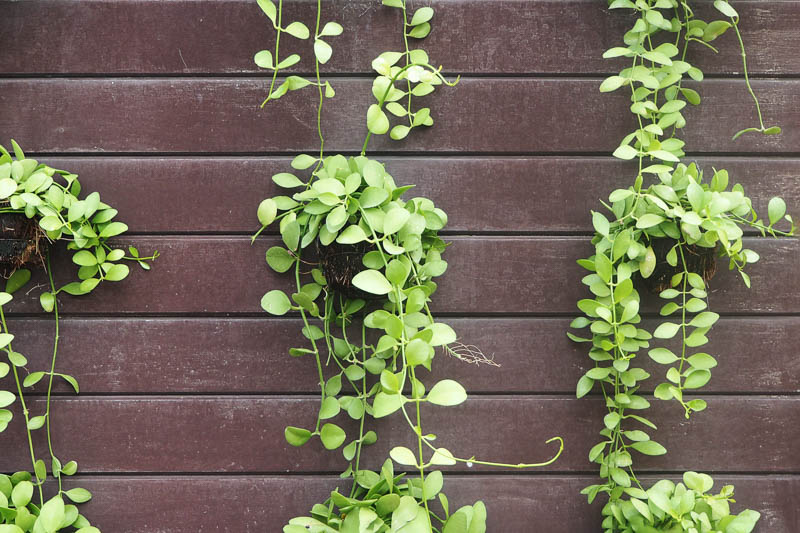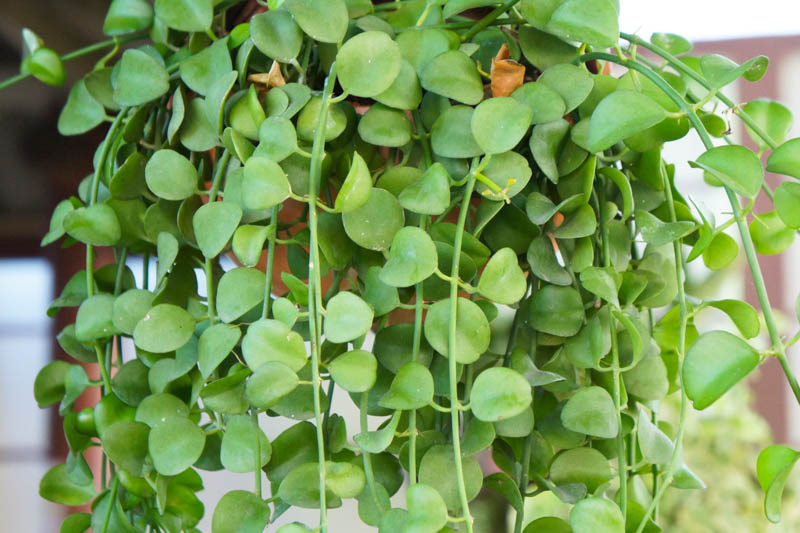Button Orchid, String of Nickels
Dischidia nummularia, also known as the string of nickels, is a fascinating and unique houseplant, ideal for adding a touch of nature to indoor environments.
Dischidia nummularia is known for its small, round, coin-like leaves that hang in cascading trails from pots, baskets, or mounted displays. The leaves are thick and fleshy, indicative of the plant’s ability to store water. Its vining habit makes it particularly attractive as a hanging plant.
Native: This plant is native to tropical regions of Australia, Asia, and the Pacific Islands. It typically grows as an epiphyte in its natural habitat, often on tree trunks in rainforests where it receives dappled sunlight. It belongs to the frangipani and hoya family Apocynaceae.
Plant Type and Habit: String of Nickels is an epiphytic perennial with a trailing or cascading growth habit.
Size: It can grow quite long under ideal conditions, reaching lengths of up to 2-3 feet (60-90 cm). The plant spreads as it grows horizontally or cascades from hanging arrangements, making its actual “spread” variable depending on how it is displayed.
Flowers: The flowers are small and inconspicuous, usually white or pale yellow, and may appear throughout the year under optimal conditions. They are not the primary reason for the plant’s popularity, as they are subtle compared to the striking foliage.
Foliage: The coin-shaped, leathery leaves are the main attraction of the String of Nickels. Their arrangement on trailing vines can create a dense mat of greenery, making the plant an excellent choice for adding lushness to indoor spaces.
Hardiness: String of Nickels is best suited for USDA zones 10-11 if grown outdoors. It does not tolerate cold and must be protected from temperatures below 50°F (10°C).
Uses: It is primarily used as an ornamental plant. It is perfect for hanging baskets, terrariums, or as a part of a green wall in homes or offices. Its trailing vines can also be trained around windows or along shelves.
Toxicity: Exercise caution when handling this plant. Its milky, white sap may cause skin irritation in some individuals. It’s advisable to keep this plant out of reach of children and pets, as the sap may be toxic if ingested.
Invasiveness: This plant is not considered invasive. It is generally well-behaved in cultivation, sticking to its assigned area without spreading aggressively.
Benefits: Its ability to adapt to a variety of indoor environments and its minimal care requirements make it a fantastic plant for novice gardeners. Additionally, it can help improve indoor air quality.

This epiphytic plant is relatively easy to grow and care for, making it a great addition to your indoor plant collection.
Light: String of Nickels prefers bright, indirect light to thrive. An east or north-facing window is ideal, as direct sunlight can scorch its leaves. If natural light is limited, consider using a grow light to provide sufficient light levels.
Soil: Use a well-draining potting mix designed for epiphytes, such as an orchid mix or a mixture containing perlite, peat, and pine bark.
Watering: This plant likes its soil to be lightly moist but not waterlogged. Water thoroughly when the top inch of the soil feels dry to the touch. Reduce watering in the winter months when the plant’s growth naturally slows down. Ensure the pot has good drainage to avoid standing water, which can lead to root rot.
Humidity: This plant thrives in a humid environment, making it well-suited for kitchens and bathrooms where humidity levels tend to be higher. If your home is dry, especially in winter, use a humidifier or place the plant on a pebble tray filled with water to increase the surrounding humidity.
Temperature: It prefers temperatures between 60°F and 80°F (16°C to 27°C), so avoid placing it near drafty windows or heat sources.
Fertilizing: Feed your String of Nickels with a diluted balanced liquid fertilizer once a month during the growing season (spring and summer). Do not fertilize in the winter. Over-fertilization can harm the plant, so it’s better to under-fertilize than overdo it.
Pruning: Prune any dead or yellowing leaves to keep the plant looking tidy and healthy. Trimming back the vines can also encourage fuller growth. If you notice the plant looking leggy, consider moving it to a brighter location.
Repotting: Repotting is rarely needed as the plant likes to be slightly root-bound. Consider repotting every 2-3 years to refresh the soil.

Propagating the String of Nickels is a straightforward and rewarding process. This plant can be easily propagated through stem cuttings, which is an effective way to multiply your collection or share this unique plant with friends and family.
Select and Cut a Stem: Look for a healthy, vigorous stem on your Dischidia nummularia plant. It should have several sets of leaves and be free of any signs of disease or pests. Using your clean, sharp scissors or shears, cut a section of stem that includes at least 3-4 nodes (the points on the stem where leaves attach). Each node has the potential to develop roots.
Prepare the Cutting: Remove the leaves from the lower half of the cutting to expose the nodes. This helps prevent rot when the cutting is planted and encourages root growth.
Apply Rooting Hormone (Optional): Apply Rooting Hormone (Optional): Dip the cut end of the stem into rooting hormone powder or liquid. This step is optional but can help accelerate root development.
Plant the Cutting: Fill a small pot with a well-draining potting mix and moisten the soil slightly. Stick the cutting into the soil, ensuring that at least two nodes are buried beneath the surface. Firm the soil around the cutting to secure it in place.
Create a Humid Environment: To maintain humidity around the cutting, cover the pot with a clear plastic bag or place it under a propagation dome. Be sure to leave space between the cutting and the cover to allow for air circulation. Place the pot in bright, indirect light.
Care for the Cutting: Keep the soil lightly moist but not waterlogged. Check for rooting by gently tugging on the cutting after a few weeks. Resistance indicates root development. This process can take anywhere from 3 to 6 weeks.
Acclimatize the New Plant: Once roots have developed, gradually acclimate the plant to less humid conditions by removing the plastic cover or dome for increasing periods each day over the course of a week.
String of Nickels (Dischidia nummularia) is relatively easy to care for but, like all plants, can be susceptible to certain pests, diseases, and common cultural problems. Identifying these issues early and managing them effectively can help ensure your plant remains healthy and attractive. Here’s what to watch out for:
Mealybugs: These pests appear as small, cottony masses in the leaf axils or on the underside of leaves. They suck sap from the plant, weakening it over time.
Spider mites: Often too small to see without magnification, spider mites can cause the leaves to appear speckled and can lead to overall plant decline if left unchecked. They thrive in dry, warm environments.
Scale insects: These can look like small, brown bumps stuck to the stems and leaves. Like mealybugs, they suck the sap and can weaken the plant.
For all these pests, a good first step is to wipe them off with a damp cloth or spray them off with water. For more severe infestations, use insecticidal soap or neem oil, applying it according to label instructions. Be vigilant and treat promptly to prevent them from spreading to other houseplants.
Root rot: This is typically caused by overwatering and poor drainage. Root rot can be fatal if not addressed quickly.
Leaf spot: Fungal or bacterial leaf spots can appear if the leaves are kept too wet or if the plant is in an overly humid environment without sufficient air circulation.
Ensure the plant is in well-draining soil and that containers have drainage holes. Water only when the top inch of the soil feels dry. If leaf spots occur, reduce leaf wetness, improve air circulation, and consider applying a fungicide if the problem persists.
Yellowing Leaves: Overwatering is a common cause of yellowing leaves in Dischidia. Underwatering can also stress the plant, leading to yellow leaves.
Dropping Leaves: Often a sign of a sudden change in environment, such as a move from a nursery to a home or from one part of your home to another. It can also be caused by temperature stress.
| Hardiness |
10 - 11 |
|---|---|
| Plant Type | Houseplants, Climbers |
| Plant Family | Apocynaceae |
| Exposure | Partial Sun |
| Season of Interest |
Spring (Early, Mid, Late) Summer (Early, Mid, Late) Fall Winter |
| Height |
2' - 3' (60cm - 90cm) |
| Spread |
10" - 1' (25cm - 30cm) |
| Maintenance | Low |
| Water Needs | Average |
| Soil Type | Loam, Sand |
| Soil pH | Acid, Neutral, Alkaline |
| Soil Drainage | Moist but Well-Drained |
| Characteristics | Showy, Evergreen |
| Native Plants | Australia |
| Garden Uses | Hanging Baskets, Patio And Containers |
| Hardiness |
10 - 11 |
|---|---|
| Plant Type | Houseplants, Climbers |
| Plant Family | Apocynaceae |
| Exposure | Partial Sun |
| Season of Interest |
Spring (Early, Mid, Late) Summer (Early, Mid, Late) Fall Winter |
| Height |
2' - 3' (60cm - 90cm) |
| Spread |
10" - 1' (25cm - 30cm) |
| Maintenance | Low |
| Water Needs | Average |
| Soil Type | Loam, Sand |
| Soil pH | Acid, Neutral, Alkaline |
| Soil Drainage | Moist but Well-Drained |
| Characteristics | Showy, Evergreen |
| Native Plants | Australia |
| Garden Uses | Hanging Baskets, Patio And Containers |
How many Dischidia nummularia (String of Nickels) do I need for my garden?
| Plant | Quantity | |
|---|---|---|
| Dischidia nummularia (String of Nickels) | N/A | Buy Plants |
Create a membership account to save your garden designs and to view them on any device.
Becoming a contributing member of Gardenia is easy and can be done in just a few minutes. If you provide us with your name, email address and the payment of a modest $25 annual membership fee, you will become a full member, enabling you to design and save up to 25 of your garden design ideas.
Join now and start creating your dream garden!
Create a membership account to save your garden designs and to view them on any device.
Becoming a contributing member of Gardenia is easy and can be done in just a few minutes. If you provide us with your name, email address and the payment of a modest $25 annual membership fee, you will become a full member, enabling you to design and save up to 25 of your garden design ideas.
Join now and start creating your dream garden!